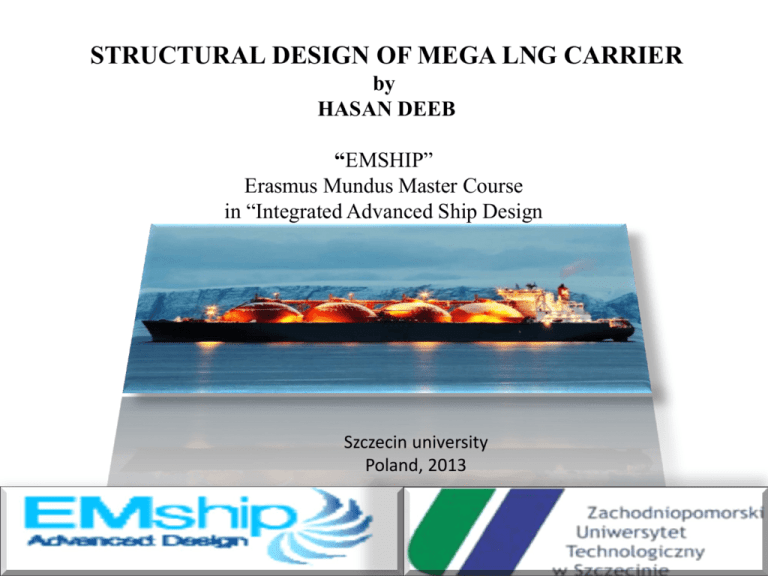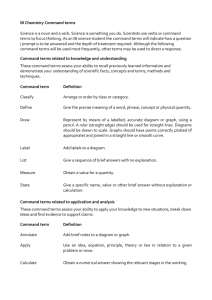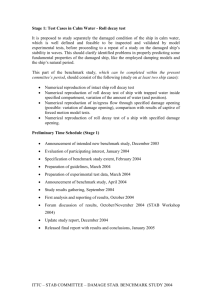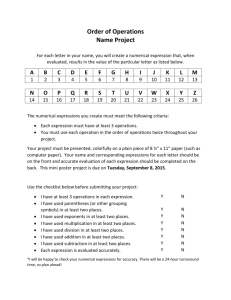Hasan Deeb
advertisement

STRUCTURAL DESIGN OF MEGA LNG CARRIER by HASAN DEEB “EMSHIP” Erasmus Mundus Master Course in “Integrated Advanced Ship Design Szczecin university Poland, 2013 SUMMERY 1 2 3 4 5 6 7 8 9 Introduction LNG ( definition, & market) Principle of ship design Main characteristics 3D model using Poseidon software Basic forces acting on ship Scantling according to GL rules Numerical calculation (FEM) Conclusion INTRODUCTION LNG Terminal Świnoujściu strategic location and advantages LNG WHAT IS LNG ? WHY LNG ? SIZE OF THE MAKET? Definition Of Problem & Scope Of Work 1- Increasing of demand on LNG sources require building bigger and bigger ships, this make the engineers in challenge to ensure the safety of ships and ability to survive carrying this huge amount of cargo. 2- Design LNG ship which can navigate under real conditions safely and numerical verification before build it in shipyard. Principle Of Ship Design Hull Forms & Type Of LNG Ships Type A Type B Type C membrane Main Characteristics Loa 293 m B 49 m T 12 m D 27 m 3D Model In Poseidon 3D Model In Poseidon Basic Forces Acting On Ship • Weight of structure of the ship • Weight of cargo • buoyancy Scantling Scantling • Section modulus values achieved according to results of scantling is W= 55.253 m³. • Value of midship section moment of inertia I = 454 m4. • • • • σ =M/W M = bending moment W = section modulus In the longitudinal girders at deck and bottom, the combined stress resulting is not to exceed 230 N/mm2. • From results maximum values is in Fr 86 : 221 Mpa in deck and 156 Mpa in bottom Load case 1: load caused by vertical bending and static torsional moment; Load case 2: load caused by vertical and horizontal bending moment as well as static torsional moment; Load case3: load caused by vertical and horizontal bending moment as well as static and wave induced torsional moment. Scantling • Results of normal stress distribution • Maximum value in Load case 1: load caused by vertical bending and static torsional moment Scantling • Shear stress distribution maximum value in load case 3 • Von Mises stress distribution Estimation Of Mass • Very important task (good results of this work will have big influence on the success of the project) • Give an idea about the coast • Move in the right direction for optimization Longitudinal plate Longitudinal stiffener Transversal plates Transversal stiffener and girders Total section weight Numerical Calculation Generate FE model 1- Mesh tolerances 2- boundary conditions Numerical Calculation Generate FE model 3- Loads specifications 3-1 External loads ( draft Marge, wave definitions ) 3-2 Internal loads Numerical Calculation Studied part, load case 1 Generate FE model 4- Selected load cases 4-1 load case 1 Loading condition 2 full tanks with empty tank in middle External pressure Hydrostatic due to static water line Cargo pressure Cargo pressure due to gravity Additional applied Rule hogging vertical design wave bending moment distribution and permissible hogging still water bending moment envelope, Msw, are to be applied. External pressure Local wave crest (to be applied to full length of FE model) 97.3 0% 97.3 97.3 Numerical Calculation Generate FE model 4- Selected load cases 4-1 load case 2 Loading condition one full tank with two empty tanks in both sides External pressure Hydrostatic due to static water line Cargo pressure Cargo pressure due to gravity Additional applied Rule sagging vertical design wave bending moment distribution and permissible sagging still water bending moment envelope, Msw, are to be applied. External pressure Local wave crest (to be applied to full length of FE model) 0% 97% 0% 97 Numerical Calculation Generate FE model Adjustment of global bending moment Numerical Calculation • Results 1- Distribution of the Von Mises stress stresses 1-1 load case 1 Numerical Calculation • Results 1- Distribution of the Von Mises stress stresses 1-1 load case 2 Numerical Calculation • Model deformations under selected load cases 1- LC1 Maximum deflection In Z = 0.14613 2- LC2 Maximum deflection In Z = -0.14082 Conclusion and comment • The resulted structural scantling from the first approach was verified using the second approach which is based on the direct calculation and carried out by performing the finite element analysis of one cargo hold located at the middle of the ship. • The objective of the ship hull structural design is achieving such hull structure capable of sustaining the different kind of loads which the ship may encounters during her life, and to serve its intended purpose. Thanks you dziękuje شكرا Let’s all hope peace for Syria and all the world Questions ?





